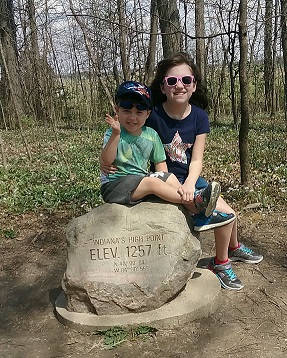Hoosier Hill on:
[Wikipedia]
[Google]
[Amazon]
Hoosier Hill is the highest natural point in the U.S. state of 


Indiana
Indiana () is a U.S. state in the Midwestern United States. It is the 38th-largest by area and the 17th-most populous of the 50 States. Its capital and largest city is Indianapolis. Indiana was admitted to the United States as the 19th s ...
with a claimed elevation of 1,257 feet (383 meters) above sea level. Hoosier Hill's claimed elevation is based on SRTM digital elevation data which is now considered to be outdated. Using newer elevation tools such as USGS's 3DEP, the top of Hoosier Hill is more like 1,255.48 feet (382.67 meters) above sea level. Hoosier Hill is in the rural area of Franklin Township, Wayne County to the northwest of Bethel. The nearest intersection to the high point is Elliot Road and County Line Road. The nearest major landmark is Interstate 70
Interstate 70 (I-70) is a major east–west Interstate Highway in the United States that runs from I-15 near Cove Fort, Utah, to a park and ride lot just east of I-695 in Baltimore, Maryland, and is the fifth-longest Interstate in the co ...
and Richmond 11 miles (17.5 km) to the south.
Hoosier Hill sits on private property owned by Kim E. Goble. The high point sits in a forested area surrounded by farmland. In 2005, an Eagle Scout candidate named Kyle Cummings (Troop 820 from Lakeside Park, Kentucky), in cooperation with the property owner, built a trail, sign and picnic area at the high point.
Geologically, the hill sits in the Dearborn Upland, an area of high terrain in southeast Indiana that sits on top of the geologic structure known as the Cincinnati Arch
The Cincinnati Arch is a broad structural uplift between the Illinois Basin to the west, the Michigan Basin to the northwest and the Appalachian Basin and Black Warrior Basin to the east and southeast. It existed as a positive topographic area du ...
. However, Hoosier Hill is located in a portion of the upland buried underneath glacial debris
A moraine is any accumulation of unconsolidated debris (regolith and rock), sometimes referred to as glacial till, that occurs in both currently and formerly glaciated regions, and that has been previously carried along by a glacier or ice she ...
known as the Tipton Till Plain. As a result, while the average elevation of this upland region is 1100±100 feet above sea level, the topographic relief is gentle where the "hill" is no more than 30 feet higher than the surrounding landscape of gently rolling farmland. While the high topography seen at Brown County State Park
Brown County State Park is located in the United States in the center of the southern half of the state of Indiana. The park is by far the largest of 24 state parks in Indiana, and occupies —making it one of the larger state parks in the Unit ...
, which sits in the Norman Upland in south central Indiana, can be mistaken to be a high point (where relief is 400–500 feet from valley to hilltop), the elevations of hilltops ranges from 800 to 1050 feet.
A.H. Marshall was the first person to successfully climb each U.S. state highpoint. He completed the task in 1936 after standing atop Hoosier Hill.
According to the local government, the wooden sign with the words, "INDIANA'S HIGHEST POINT" would frequently be stolen, so in 2016 the wooden sign was permanently replaced by an engraved boulder.


See also
* Outline of Indiana * Index of Indiana-related articles * List of U.S. states by elevation * Sand Hill, Indiana's second highest named point *Weed Patch Hill
Weed Patch Hill, also known as Weed Patch Knob (), is the third highest named summit in the U.S. state of Indiana. Located in Washington Township and Brown County State Park, it is the highest point in the Knobstone Escarpment.
In Indiana, on ...
, Indiana's third highest named point
References
External links
* Hills of Indiana Landforms of Wayne County, Indiana Highest points of U.S. states {{WayneCountyIN-geo-stub